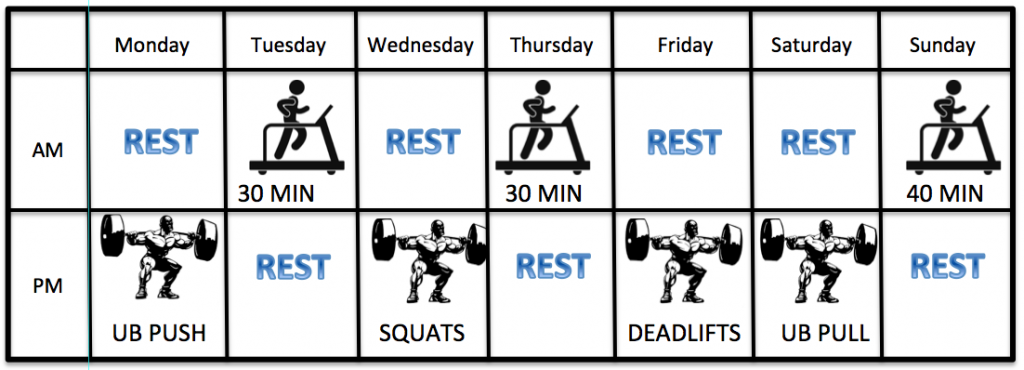Will Cardio Give Your Weight Training An Advantage?
There’s a common argument among people who work out as to which is better: weight training or cardio? Some say cardio will sap your gains, pointing to elite marathon runners versus sprinters (hint, it won’t sap your gains if you’re eating food and logging less than 10 hours a week or mileage). Others say only weight training will make you unable to climb stairs without wheezing and sweating more than a summer in Florida.

A common argument against the “this versus that” would be the simplest one: Why not both?
Cardio can have a big impact on weight training performance and goal attainment in a couple of big ways, and can vary that impact depending on what your main training goal may be and how you incorporate it.
First, cardio training after intense workouts can have a big impact on nutrient delivery into tissues and waste removal. This can help speed recovery while also allowing a greater work endurance during weight training exercise. Consider this: recovery phases within sessions are meant to bring oxygen back into muscles, remove waste, and recover energy to perform another set. By having a more well developed oxygen transfer system via cardio training, you can recover faster between sets, and also extend the lifespan of your workouts due to this improved recovery, which can help increase the number of working sets you can do in a workout at a given intensity before failure, a major contributing factor to muscle hypertrophy and strength gains.

Using cardio to improve this facet of training isn’t difficult and doesn’t take a lot of work. 2-3 workouts a week working at an intensity close to or slightly above anaerobic threshold (the point where you’re using more oxygen than your body can bring in) can have significant improvements in tissue oxygenation rate and recovery, while not requiring massive wear and tear on the body compared to something like training for a marathon. There’s nothing wrong with marathon training, but it usually takes more of a focus than weight training.
Next cardio training concurrently with weight training can have significant impacts on body composition. In the vast majority of studies published on the topic, concurrent training helped maintain muscle mass while promoting a loss of body fat, something most people are looking to see happen anyway.
To get this benefit, most recommendations would be either accumulated calories burned through the week (less total time if you’re doing it more frequently, more time if you’re only training once or twice a week), or at a similar intensity to the threshold workouts described above.
Third, low intensity cardio activity can be used as an effective recovery tool following or during blocks of intense heavy training. This could include a long walk, and easy bike, or any activity that you can do while still holding a conversation with someone without being breathless.
A great time to include low-intensity recovery cardio would be after 3 consecutive days of resistance training. Most people can power through 3 days relatively well, but delayed onset soreness can make throwing a 4th in there a bit challenging, plus a brief mental and physical break can be quite refreshing before the next workout.
Let’s look at some sample training splits for each goal.
Strength
You could easily incorporate cardio on a daily basis with resistance training, as long as it wasn’t so intense and draining that it took away from the ability to perform the strength training with optimal intensity. Alternatively, you could do cardio training on it’s own as a break from the weight training, or in alternation with the weight training.
Example 1:

Example 2:

In both examples, the total time per week spent doing some form of cardio is around 120 minutes, considerably less than needed to train for a marathon and to “risk losing your gains,” but enough to potentially stimulate some improved oxygen utilization, burn some calories, and help reduce the stress of heavy and hard training.
These examples could also be used with weight loss goals, with the only small variations being maybe doing total body weight training sessions compared to blocking for specific movements or body parts as seen in strength training. You could do either, but in most instances, total body strength training will help burn more calories compared to isolational work, even at matched intensities.
Cardio shouldn’t be viewed as the enemy of strength training, but as a great addition to a solid program that can only benefit in the long and short term. A major consideration is the total volume of training being done, as massive amounts of time on cardio can be deleterious to training for strength, however, the exact time for this to happen will usually range from 5-15 hours a week for most people. Less than that and you’re golden, Pony Boy.
If you’re looking for quality cardio equipment, you should check out Johnson Fitness. Their line of consumer quality equipment have received multiple awards and are available throughout the United States.

They were kind enough to sponsor this post to discuss how cardio training can benefit your weight training, so if you’re in the market for a new piece of cardio hotness for your home workouts, you should definitely check them out.
2 Responses to Will Cardio Give Your Weight Training An Advantage?